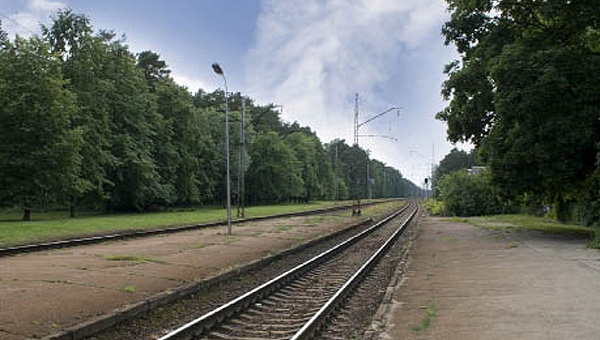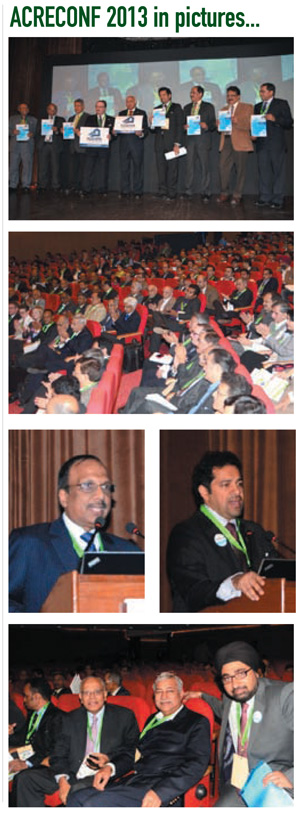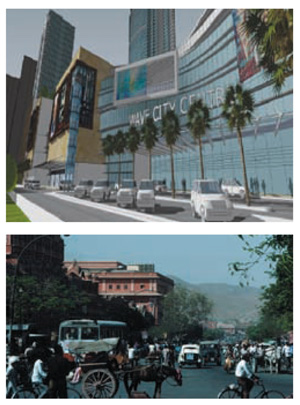The usual dismissive eyerolling at the mention of the importance of cold chain is fast becoming a thing of the past
The usual dismissive eyerolling at the mention of the importance of cold chain is fast becoming a thing of the past in a country that is rapidly becoming urbanised with even two-tier and three-tier towns mimicking lifestyles of metropolises.
Part I of our report. Report by Pratibha Umashankar with inputs from B Surendar

ACRECONF 2013, a two-day international conference held on February 8 and 9, in New Delhi, organised by the Delhi Chapter of ISHRAE, in association with ASHRAE India Chapter, had the avowed theme “360 Degree View on Emerging Mega Trends in Building Design”. When building design is the focus, can HVACR be far behind? Ergo, the delegates pondered over the issues related to Net-zero energy buildings, energy-efficient equipment, reducing carbon footprint and heating, refrigeration and air conditioning engineering. Not surprisingly, it had a session dedicated to cold chain.
 ACREX 2013, touted to be the largest biennial International Exhibition and Conference catering to the air conditioning, refrigeration, ventilation and building services’ industries, held in Mumbai on March 7 and 8, once again organised by ISHRAE, too focused on the HVACR sector.
ACREX 2013, touted to be the largest biennial International Exhibition and Conference catering to the air conditioning, refrigeration, ventilation and building services’ industries, held in Mumbai on March 7 and 8, once again organised by ISHRAE, too focused on the HVACR sector.
The events, especially ACRECONF, highlighted the fact that transport refrigeration is a somewhat neglected area in India. However, the usual dismissive eye-rolling at the mention of the importance of cold chain is fast becoming a thing of the past in a country that is rapidly becoming urbanised with even two-tier and three-tier towns mimicking lifestyles of metropolises, with a wide variety of food and beverages being transported across the land – often in hot and humid weather – to cater to a largely young populace with a disposable income.
At the other end of the spectrum, the Food Security Bill, which is mandated to provide rice, wheat and other food grains at very cheap rates to the poor, will soon become a reality, with the Cabinet giving its nod to it, and the Parliament, which, at the time of this magazine going to press, was expected to pass it. This will entail an efficient public distribution system (PDS), which is a massive exercise, considering the country’s size.
Given this scenario, cold chain – and concerns around it – has gained immediacy and urgency.
What gets frozen?
The frozen foods market in India typically comprises green peas, ice-cream, meat, corn, okra, mixed vegetables, mango pulp, ready-to-eat foods, tinned fruit, poultry and dairy products. Cold chain also has under its umbrella, pre-cooling, which is accelerated cooling immediately after harvesting, and includes strawberries, pomegranates and mangoes.
In India, controlled atmosphere (CA) storage is primarily used for apples and pears, and extends the life of the produce by six to eight months, or longer.
While cold chain is fairly well established for milk producers in the country, and to a lesser extent, fish, meat and poultry products, it’s still in its infancy when it comes to fruits and vegetables, as also CA technology, conceded Harshil Surange of ACR Consultants, Pune.
He listed the following facts and trends:
The present capacity of CA technology is around 50,000 metric tonnes (MT), with an expected target of 100,000 MT, due to the huge potential for CA in India. For example, there are many CA facilities in the state of Himachal Pradesh to store apples.
The pre-frozen market:
Inventory management system; dry storage; pre-cooling; blast freezing; plus-temperature storage; and minus-temperature storage, among others. They deal with everything from grading, sorting and ripening to being involved in delivery docks and administration units.
Trends:
Benefits
An efficient and qualitatively superior cold chain can certainly reap rich rewards for both the producer and the user. Capt Pawanexh Kohli, Chief Advisor, National Centre for Cold-chain Development, listed the following benefits of a strong cold chain:
Bringing cold chain out of the freezer
Undoubtedly, given India’s growth rate in an increasingly globalised world, its aspiration to become a regional power and its rapid urbanisation, the cold chain industry has immense potential as well as opportunities in India. There are cold hard facts to support this.
“India produces 115 million MTL of milk; it is the No 1 milk producer in the world; it is No 2 in the production of fruits and vegetables; and No 6 in fish,” says Surange.
Kohli put forward the following facts:
The government, on its part, has come out with several incentives to encourage farmers and the cold chain industry and related sectors. Surange enumerated a few: “Excise concessions, service tax exemptions and the National Horticultural Board coming up with technical standards, with more in the pipeline.”
“The government allows 100% FDI in cold chain, and NCCD, APEDA (Agricultural and Processed Food Products Export Development Authority), NABARD (National Bank for Agriculture and Rural Development), SFAC (Small Farmers’ Agri-business Consortium) are supporting bodies, and there are 56 farmer-producer organisations (FPOs),” added Kohli.
Yet, none of this has made an appreciable impact on the cold chain industry. What, indeed, is keeping farmers from developing cold chain infrastructure? When posed with this question by the moderator during a discussion at ACRECONF, Kohli replied: “Too many of them are too small, so the challenge is in grouping them. FPOs are now being given 100% subsidy. So we need to enable farmers to help them achieve their full potential.
“McDonalds monitors its meat all the way through the cold chain. In India, the farmer does not monitor his produce all the way. So there is ownership missing.” Kohli believed that the producer-owner model is a good option to rectify this.
He pointed to another conundrum: “The cold chain business is profitable. People say it’s not profitable. But, there is an ulterior motive for this, because they will not get subsidies from NHB, etc., if they say it’s profitable. Though they say it’s not profitable, they keep building more cold storage units.”
While this is one of the many challenges wired into the politico-economic mindset of the country, there are several other technical and infrastructural roadblocks, which the cold chain industry can, perhaps, help overcome.
The weakest links in the chain
Surange listed lack of quality road network, which impacts transport refrigeration; shortage of good quality water; excessive use of pesticides; lack of availability of trained personnel; and high initial cost of projects (ROI five to six years) as few of the problems that need to be addressed. “Maharashtra has started giving subsidised agricultural tariffs for electricity for cold storages, which is good,” he conceded, and added: “It’s important to identify the product and the ROI. Apples and pears are sold at Rs 200 (USD 3.68, as of the March 30 value of the Indian Rupee against the US Dollar) a kilo, so the cost justifies the means.”
Kohli identified another culprit when he said: “Farmers have ramped up production due to food inflation. Yet, there is shortage of food in the country, owing to broken links in the cold chain. Reefer transportation is lagging in capacity. There are only 7,000 reefer trucks in the country, serving 30.4 million MT. So only seven million metric tonnes of food is moving on the roads.
 Kohli listed other issues besieging the food industry:
Kohli listed other issues besieging the food industry:
He also identified issues of concern, which he believed the government needs to address:
Anil Mathur of Danfoss, revealed that there is 40% to 50% loss of food products in India, whereas there is only 10% to 15% loss of food products in developed countries.” This is a sad commentary on the state of affairs in the food chain sector.
KK Mitra, VP of Lloyd Insulation, while corroborating this, pointed out that though India is the largest producer of various food products, the choice and quantity available for consumers is low, due to wastage. “We ought to treat a [food] commodity like a human being,” he said. However, this is not the case in India. Huge quantities of foodstuff and farm produce is lost due to poor management, lack of proper preservation and an unreliable and inefficient cold chain, which includes challenges of interrupted power supply and poor insulation.
Mitra revealed that a lot of cold stores in India have closed down owing to thermal insulation failure. “So, it’s important to have field stores at every important centre to prevent rapid deterioration in 30°C heat,” he suggested, but added: “Refrigeration will bring down the temperature. But for how long can we have low temperature? So, it’s up to insulation. And finally insulation saves energy.”
Insulating against failure:
In his presentation at ACRECONF titled “Thermal insulation systems for energy efficiency”, Mitra said “India is a tropical country, so insulation is a necessity. Walls get affected by high temperature. The bitumen incorporated in them melts (at 25°C), so the insulation comes loose. Hence, proper installation of insulation is important.”
He put forward facts to reinforce his point:
When it comes to thermal insulation for buildings, high-ambient condition continuously affects roof with heat ingress, and insulation will stop heat/cold ingress from outside; transmission load of roof and walls accounts for 30% of all the power consumed by built area, which can be saved with efficient insulation.
Mitra listed things to be factored in:
Overcoming challenges
While government incentives will go a long way in helping the cold chain industry, as also the farmers, incentives can also tie the sector in knots, either due to redtape or systemic failure due to complacency, apathy and lack of continuous and consistent monitoring. Just as systems can fail the beneficiaries, so can beneficiaries fail the system. Appropriate use of government handouts by all the stakeholders is one way of making the cold chain work. Making it a well-oiled machinery by strengthening all the links is another, wherein the industry has a role to play.
“Applying insulation in existing cold storage facilities is an exciting possibility,” said Mitra.
Surange believed that beefing up refrigerated transport for processed and preserved food will help the sector.
Speaking from his company’s standpoint, Mathur added: “Danfoss has solutions for the entire value chain from farm to fork – it has VLT refrigeration drives (VSDs adapted for refrigeration applications). The company’s ADAP KOOL solutions for convenience stores and supermarkets is a neat fit. It represents a smart solution, wherein it is possible to control temperature from remote locations.”
Kohli listed his set of solutions to enable the industry to make a mark:
Conclusion
With changing lifestyle of nuclear families, demand for processed and refrigerated food is increasing in India. Rapid urbanisation will continue to lead to proliferation of food retail, and thereby cold chain. The entry of retail giants like Wal-Mart will drive the sector forward, and hopefully bring about standardisation and sustainability. “Danfoss is involved in Bharti Wal-Mart, and has realised 25% reduction in energy consumption,” revealed Mathur, adding credence to this.
The country and the sector need to be ready for FDI, both in terms of changing to an international mindset and getting its act together in terms of infrastructure to harvest the low-hanging fruit of retail. But in the rush to do so, the challenge is not to lose sight of energy efficiency and sustainability, as they will not only test the strength of the sector, but will strengthen the sector.
Note: The report is based on interviews conducted at ACRECONF 2013 held in February in New Delhi and ACREX 2013 held in Mumbai in March.
Cold chain is hot Vikash Sekhani, Director, SAFE A&T Technology Private Limited, India, shared the following information during a chat with B Surendar on the sidelines of ACREX 2013: Vikash Sekhani, Director, SAFE A&T Technology Private Limited, India, shared the following information during a chat with B Surendar on the sidelines of ACREX 2013:
“The refrigeration (cold chain) industry is growing at a phenomenal rate. The government is giving incentives. Earlier, there used to be only Amul (a popular dairy in India); now, we see international brands and more local brands of dairy products like pasteurised milk. So, cold chain is the market. That is where the growth will be. “We, at our company, are into the components business. We are making available a lot of components for the cold chain industry – accumulators, receivers…. For a long time, we were making two models of these; today, we are making 10 models. So that is where the growth has been. Overall, VRFs and cold chain are the most promising markets.” |
| Going on the Blink …A detailed report titled “Frost & Sullivan’s Inputs on India’s Crippling Power Infrastructure” highlights India’s tenuous power supply:
“In the wee hours of Sunday, July 29, 2012, India witnessed one of its worst power failures in over a decade. An inter-connect substation near Agra (in north-central India) tripped, followed by the automatic shutdown of all power generation plants in the Northern region. The following day witnessed a more widespread collapse, which included not just the Northern grid, but also the Eastern and North Eastern power grids, extending power failure to 19 states and two Union Territories, covering half of India’s population. “It has emerged that a few states (Uttar Pradesh, Haryana, Rajasthan, and Punjab) in the Northern grid overdrew power beyond their permissible limits, ignoring strong warnings from the Northern Regional Load Dispatch Center (NRLDC) and the Central Electricity Regulatory Commission (CERC) to maintain grid discipline and stop overdrawal.” This does not bode well not only for the cold chain sector, but also the HVACR sector, in general. In the same report, Amol Kotwal, Deputy Director, Energy & Power Systems Practice, Frost & Sullivan, South Asia, Middle East and North Africa, offered solutions under the rubric “The way out”: “India’s power infrastructure requires a major overhaul, which involves some major reforms and policy implementation across the entire value chain. From an action standpoint, this would involve combination of increased generation capacity, efficient T&D infrastructure and better grid control. Besides these, reducing theft and wasteful usage of electricity, revised power tariffs and better billing systems would lead to customers paying accurately for exact power consumption, thus curbing wastage.” |
Copyright © 2006-2025 - CPI Industry. All rights reserved.